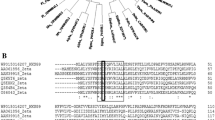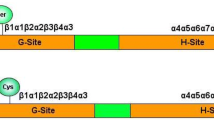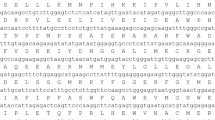Abstract
Key message
The relative position of domains is critical for enzymatic properties of tau class glutathione S-transferases, and altering the position of linker far away from the active center affects catalytic property.
Abstract
Glutathione S-transferases (GSTs) are a family of phase II detoxification enzymes whose main function is to improve plant resistance to stresses. To understand the structural effects of tau class GSTs on their function, using OsGSTU17 as an example, we predicted the residues involved in the interactions between its domains and linker region. We further detected the structural changes in mutants and the corresponding changes in terms of substrate activity and kinetic parameters. Four pairs of residues, including Ala14 and Trp165, Arg20 and Tyr154, Glu74 and Arg98, Asp77 and Met87, forming hydrogen bonds and salt bridges were found to play important roles in maintaining the relative position between the domains and linker region inside the protein. The hydrogen bond between Trp165 and Ala14 affected the structural stability has been demonstrated in our previous study. The mutant R20A lost almost all catalytic activity. Interestingly, the mutant E74A exhibited a significant decrease in activity towards 7-chloro-4-nitrobenzo-2-oxa-1, 3-diazole, 1-chloro-2, 4-dinitrobenzene and 4-nitrobenzyl chloride, while its activity towards substrate cumene hydroperoxide remained unchanged. Compared with other mutants, the mutant D77A exhibited decreased affinity to its substrates and increased activity towards 1-chloro-2, 4-dinitrobenzene and cumene hydroperoxide, but its thermodynamic stability did not change significantly. The relative position of individual domain was critical for enzymatic properties, and the linker which is far away from the active site could change the enzymatic properties of GSTs via altering the relative position of the individual domain. Our results provide insights into the relationship between structure and function of tau class GSTs.








Similar content being viewed by others
Data archiving statement
The sequences of mutants of OsGSTU17 are available in the Dryad (DOI: https://doi.org/10.5061/dryad.zgmsbcc7p).
References
Armstrong RN (1997) Structure, catalytic mechanism, and evolution of the glutathione transferases. Chem Res Toxicol 10(1):2–18. https://doi.org/10.1021/tx960072x
Axarli I, Dhavala P, Papageorgiou AC, Labrou NE (2009a) Crystal structure of Glycine max glutathione transferase in complex with glutathione: investigation of the mechanism operating by the Tau class glutathione transferases. Biochem J 422(2):247–256. https://doi.org/10.1042/bj20090224
Axarli I, Dhavala P, Papageorgiou AC, Labrou NE (2009b) Crystallographic and functional characterization of the fluorodifen-inducible glutathione transferase from Glycine max reveals an active site topography suited for diphenylether herbicides and a novel L-site. J Mol Biol 385(3):984–1002. https://doi.org/10.1016/j.jmb.2008.10.084
Axarli I, Georgiadou C, Dhavala P, Papageorgiou AC, Labrou NE (2010) Investigation of the role of conserved residues Ser13, Asn48 and Pro49 in the catalytic mechanism of the tau class glutathione transferase from Glycine max. Biochem Biophys Acta 1804(4):662–667. https://doi.org/10.1016/j.bbapap.2009.10.016
Böhm G, Muhr R, Jaenicke R (1992) Quantitative analysis of protein far UV circular dichroism spectra by neural networks. Protein Eng 5(3):191–195. https://doi.org/10.1093/protein/5.3.191
Bowie J, Luthy R, Eisenberg D (1991) A method to identify protein sequences that fold into a known three-dimensional structure. Science 253(5016):164–170
Cummins I, Dixon DP, Freitag-Pohl S, Skipsey M, Edwards R (2011) Multiple roles for plant glutathione transferases in xenobiotic detoxification. Drug Metab Rev 43(2):266–280. https://doi.org/10.3109/03602532.2011.552910
Dirr H, Reinemer P, Huber R (1994) X-ray crystal structures of cytosolic glutathione S-transferases. Implications for protein architecture, substrate recognition and catalytic function. Eur J Biochem 220(3):645–661. https://doi.org/10.1111/j.1432-1033.1994.tb18666.x
Dixon DP, Edwards R (2010) Roles for stress-inducible lambda glutathione transferases in flavonoid metabolism in plants as identified by ligand fishing. J Biol Chem 285(47):36322–36329. https://doi.org/10.1074/jbc.M110.164806
Dixon DP, Lapthorn A, Edwards R (2002) Plant glutathione transferases. Genome Biol. https://doi.org/10.1186/gb-2002-3-3-reviews3004
Dixon DP, Lapthorn AJ, Edwards R (2005) Synthesis and analysis of chimeric maize glutathione transferases. Plant Sci 168(4):873–881. https://doi.org/10.1016/j.plantsci.2004.11.009
Edwards R, Dixon DP (2005) Plant glutathione transferases. Methods Enzymol 401:169–186. https://doi.org/10.1016/s0076-6879(05)01011-6
Edwards R, Dixon DP, Walbot V (2000) Plant glutathione S-transferases: enzymes with multiple functions in sickness and in health. Trends Plant Sci 5(5):193–198
Frear DS, Swanson HR (1970) Biosynthesis of S-(4-ethylamino-6-isopropylamino- 2-s-triazino) glutathione: partial purification and properties of a glutathione S-transferase from corn. Phytochemistry 9(10):2123–2132. https://doi.org/10.1016/S0031-9422(00)85377-7
Frova C (2003) The plant glutathione transferase gene family: genomic structure, functions, expression and evolution. Physiol Plant 119(4):469–479. https://doi.org/10.1046/j.1399-3054.2003.00183.x
Frova C (2006) Glutathione transferases in the genomics era: new insights and perspectives. Biomol Eng 23(4):149–169. https://doi.org/10.1016/j.bioeng.2006.05.020
Greenfield NJ (1996) Methods to estimate the conformation of proteins and polypeptides from circular dichroism data. Anal Biochem 235(1):1–10. https://doi.org/10.1006/abio.1996.0084
Greenfield NJ (2006) Using circular dichroism spectra to estimate protein secondary structure. Nat Protoc 1(6):2876–2890. https://doi.org/10.1038/nprot.2006.202
Habig WH, Pabst MJ, Jakoby WB (1974) Glutathione S-transferases. The first enzymatic step in mercapturic acid formation. J Biol Chem 249(22):7130–7139
Hall TA (1999) BioEdit: a user-friendly biological sequence alignment editor and analysis program for Windows 95/98/NT. Nucleic Acids Symp Ser 41:95–98
Ho SN, Hunt HD, Horton RM, Pullen JK, Pease LR (1989) Site-directed mutagenesis by overlap extension using the polymerase chain reaction. Gene 77(1):51–59. https://doi.org/10.1016/0378-1119(89)90358-2
Hossain MD, Yamada N, Yamamoto K (2014) Glutathione-binding site of a bombyx mori theta-class glutathione transferase. PLoS ONE 9(5):e97740. https://doi.org/10.1371/journal.pone.0097740
Islam S, Rahman IA, Islam T, Ghosh A (2017) Genome-wide identification and expression analysis of glutathione S-transferase gene family in tomato: gaining an insight to their physiological and stress-specific roles. PLoS ONE 12(11):e0187504–e0187504. https://doi.org/10.1371/journal.pone.0187504
Kumar S, Trivedi PK (2018) Glutathione S-transferases: role in combating abiotic stresses including arsenic detoxification in plants. Front Plant Science 9:751. https://doi.org/10.3389/fpls.2018.00751
Lan T, Wang XR, Zeng QY (2013) Structural and functional evolution of positively selected sites in pine glutathione S-transferase enzyme family. J Biol Chem 288(34):24441–24451. https://doi.org/10.1074/jbc.M113.456863
Lo Piero AR, Mercurio V, Puglisi I, Petrone G (2010) Different roles of functional residues in the hydrophobic binding site of two sweet orange tau glutathione S-transferases. FEBS J 277(1):255–262. https://doi.org/10.1111/j.1742-4658.2009.07481.x
Moons A (2005) Regulatory and functional interactions of plant growth regulators and plant glutathione S-transferases (GSTs). In: Litwack G (ed) Vitamins & hormones, vol 72. Academic Press, New York, pp 155–202. https://doi.org/10.1016/S0083-6729(05)72005-7
Nijtmans LG, Henderson NS, Holt IJ (2002) Blue Native electrophoresis to study mitochondrial and other protein complexes. Methods 26(4):327–334. https://doi.org/10.1016/s1046-2023(02)00038-5
Oakley A (2011) Glutathione transferases: a structural perspective. Drug Metab Rev 43(2):138–151. https://doi.org/10.3109/03602532.2011.558093
Pavlidi N, Vontas J, Van Leeuwen T (2018) The role of glutathione S-transferases (GSTs) in insecticide resistance in crop pests and disease vectors. Curr Opin Insect Sci 27:97–102. https://doi.org/10.1016/j.cois.2018.04.007
Piromjitpong J, Wongsantichon J, Ketterman AJ (2007) Differences in the subunit interface residues of alternatively spliced glutathione transferases affects catalytic and structural functions. Biochem J 401(3):635–644. https://doi.org/10.1042/bj20060603
Ricci G, Caccuri AM, Lo Bello M, Pastore A, Piemonte F, Federici G (1994) Colorimetric and fluorometric assays of glutathione transferase based on 7-chloro-4-nitrobenzo-2-oxa-1,3-diazole. Anal Biochem 218(2):463–465. https://doi.org/10.1006/abio.1994.1209
Roxas VP, Smith RK Jr, Allen ER, Allen RD (1997) Overexpression of glutathione S-transferase/glutathione peroxidase enhances the growth of transgenic tobacco seedlings during stress. Nat Biotechnol 15(10):988–991. https://doi.org/10.1038/nbt1097-988
Roxas VP, Lodhi SA, Garrett DK, Mahan JR, Allen RD (2000) Stress tolerance in transgenic tobacco seedlings that overexpress glutathione S-transferase/glutathione peroxidase. Plant Cell Physiol 41(11):1229–1234. https://doi.org/10.1093/pcp/pcd051
Schonbrunn E, Eschenburg S, Luger K, Kabsch W, Amrhein N (2000) Structural basis for the interaction of the fluorescence probe 8-anilino-1-naphthalene sulfonate (ANS) with the antibiotic target MurA. Proc Natl Acad Sci USA 97(12):6345–6349. https://doi.org/10.1073/pnas.120120397
Segawa S, Fukuno T, Fujiwara K, Noda Y (1991) Local structures in unfolded lysozyme and correlation with secondary structures in the native conformation: helix-forming or -breaking propensity of peptide segments. Biopolymers 31(5):497–509. https://doi.org/10.1002/bip.360310505
Slavik J (1982) Anilinonaphthalene sulfonate as a probe of membrane composition and function. Biochem Biophys Acta 694(1):1–25. https://doi.org/10.1016/0304-4157(82)90012-0
Sylvestre-Gonon E, Law SR, Schwartz M, Robe K, Keech O, Didierjean C, Dubos C, Rouhier N, Hecker A (2019) Functional, structural and biochemical features of plant serinyl-glutathione transferases. Front Plant Sci 10:608. https://doi.org/10.3389/fpls.2019.00608
Thom R, Cummins I, Dixon DP, Edwards R, Cole DJ, Lapthorn AJ (2002) Structure of a tau class glutathione S-transferase from wheat active in herbicide detoxification. Biochemistry 41(22):7008–7020. https://doi.org/10.1021/bi015964x
Vargo MA, Nguyen L, Colman RF (2004) Subunit interface residues of glutathione S-transferase A1-1 that are important in the monomer-dimer equilibrium. Biochemistry 43(12):3327–3335. https://doi.org/10.1021/bi030245z
Wang CL, Yang HL (2011) Conserved residues in the subunit interface of tau glutathione s-transferase affect catalytic and structural functions. J Integr Plant Biol 53(1):35–43. https://doi.org/10.1111/j.1744-7909.2010.01005.x
Winayanuwattikun P, Ketterman AJ (2005) An electron-sharing network involved in the catalytic mechanism is functionally conserved in different glutathione transferase classes. J Biol Chem 280(36):31776–31782. https://doi.org/10.1074/jbc.M502612200
Yang X, Sun W, Liu JP, Liu YJ, Zeng QY (2009) Biochemical and physiological characterization of a tau class glutathione transferase from rice (Oryza sativa). Plant Physiol Biochem 47(11–12):1061–1068. https://doi.org/10.1016/j.plaphy.2009.07.003
Yang X, Wei J, Wu Z, Gao J (2020) Effects of substrate-binding site residues on the biochemical properties of a tau class glutathione S-transferase from Oryza sativa. Genes 11(1):25
Zeng QY, Wang XR (2005) Catalytic properties of glutathione-binding residues in a tau class glutathione transferase (PtGSTU1) from Pinus tabulaeformis. FEBS Lett 579(12):2657–2662. https://doi.org/10.1016/j.febslet.2005.03.086
Acknowledgements
This work was funded by the National Key R&D Program of Ministry of Agriculture and Rural Affairs of the People’s Republic of China [2018YFD0300207-2]; Department of Science and Technology of Jilin Province [20190301061NY]. We would like to thank the State Key Laboratory of Systematic and Evolutionary Botany, Institute of Botany, the Chinese Academy of Sciences for enzyme property testing equipment support. And we would like to thank the Technology Center of Protein Research, Tsinghua University and Dr. Xuemin Han of Chinese Academy of forestry for their help in protein circular dichroism spectra. We would like to thank TopEdit (www.topeditsci.com) for English language editing of this manuscript.
Author information
Authors and Affiliations
Contributions
XY and JG contributed to the study conception and design. ZW advised on experimental design and acquired funding. XY performed most of the experiments and data analyses and writing of the article. XY and JG revised the paper during the paper submission and revision. All authors commented on previous versions of the manuscript. All authors read and approved the final manuscript.
Corresponding authors
Ethics declarations
Conflicts of interest
The authors declare that they have no conflict of interest.
Additional information
Publisher's Note
Springer Nature remains neutral with regard to jurisdictional claims in published maps and institutional affiliations.
Electronic supplementary material
Below is the link to the electronic supplementary material.
Rights and permissions
About this article
Cite this article
Yang, X., Wu, Z. & Gao, J. Effects of conserved Arg20, Glu74 and Asp77 on the structure and function of a tau class glutathione S-transferase in rice. Plant Mol Biol 105, 451–462 (2021). https://doi.org/10.1007/s11103-020-01099-4
Received:
Accepted:
Published:
Issue Date:
DOI: https://doi.org/10.1007/s11103-020-01099-4




